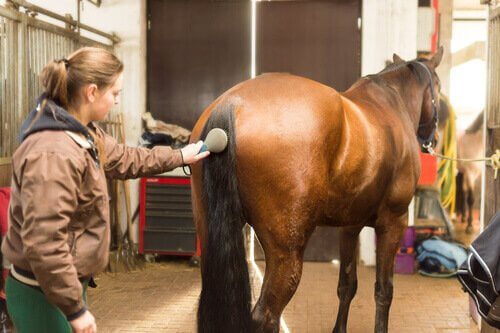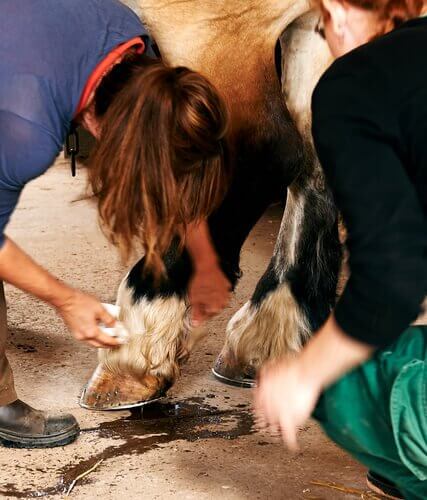All You Need to Know about a Horse's Daily Cleaning

Brushing and daily cleaning are part of the basic care that your horse needs to keep in good health. Sanitizing its skin and fur isn’t just a matter of aesthetics. It’s also essential for preventing diseases and improving a horse’s physical and cognitive performance. We’ll tell you all about a horse’s daily cleaning, and all that it should entail, in this article.
Hygiene and brushing not only improve the appearance of a horse’s skin and hair, but they also prevent skin diseases such as scabies in horses.
Basic elements for your horse’s daily cleaning
To provide optimal sanitation for your horse, you’ll need the appropriate tools. Using those tools to clean your horse on a daily basis is essential for improving the health and appearance of its skin and hair.
In addition, it’s also an excellent opportunity to check your horse’s body for parasites, wounds, or any other problem that requires veterinary care.

Next, we’ll list the accessories you’ll need to assemble a complete daily cleaning kit for your horse:
Curry Comb
The curry comb is a type of horse brush that is used to remove dirt and impurities from a horse’s coat. You can find oval, square, and round models in stores, made of plastic or rubber.
This tool should only be used on the fleshy parts of a horse’s body, such as its neck and rump. How you use it and in which direction you brush depends on the shape of the curry comb.
For oval and round models, make small circular motions as if you were giving a soft massage. Square curry combs or ones with handles are used in straight lines.
Dandy brush
Dandy brushes have long, hard, thick bristles, which can be either natural or plastic. The back can be made of wood or plastic, without affecting the final results of your brushing.
They are usually used to remove dry mud or manure that adheres to a horse’s coat. We recommend natural bristles, since they produce a better finish and only remove dead hair. If you use plastic bristles, be careful not to pull hairs from the tail and mane.
Body brush
This is one of the most recognizable tools we can use for a horse’s daily cleaning routine. It’s a special brush that owners use to remove excess grease, sweat, dandruff, or impurities from the skin and fur.
A body brush is oval and has small soft bristles. The back of it can be wood, leather, or plastic. Although you can use it on the horse’s entire body, it’s most useful on the tail and mane.
Mane combs
You can use these combs in a horse’s daily cleaning routine to remove knots where there is long, soft hair. These products are usually plastic or metal. We recommend using metal ones.
When a horse’s mane is dense and voluminous, you should use a brush to untangle it. A comb can pull hairs out and hurt the horse. In addition, it’s not very effective on thick, abundant hair.
Sweat scraper
Sweat scrapers eliminate excess fluids from a horse’s skin and hair– either sweat or water. Usually, it consists of a metal or rubber sheet with a sturdy wooden or plastic handle.
Hoof pick
You can use a hoof pick or farrier brush to remove mud, stones, manure and any other residue from horses’ hooves. Usually, it comes with a special brush to clean the hooves.

Wet sponge
This is a simple, cheap tool that removes impurities from hairless, sensitive areas. With a wet sponge, you can gently clean around the eyes, anus, nostrils, and genital region of the horse.
Of course, we recommend using different sponges for a horse’s rear and frontal areas, without interchanging them. That way, you’ll never use the same sponge to clean a horse’s face and genitals.
With this complete kit and the tips above, you’ll be able to carry out your horse’s daily cleaning routine more easily and effectively. However, remember to consult a veterinary specialist if you see anything abnormal on your horse’s body.
